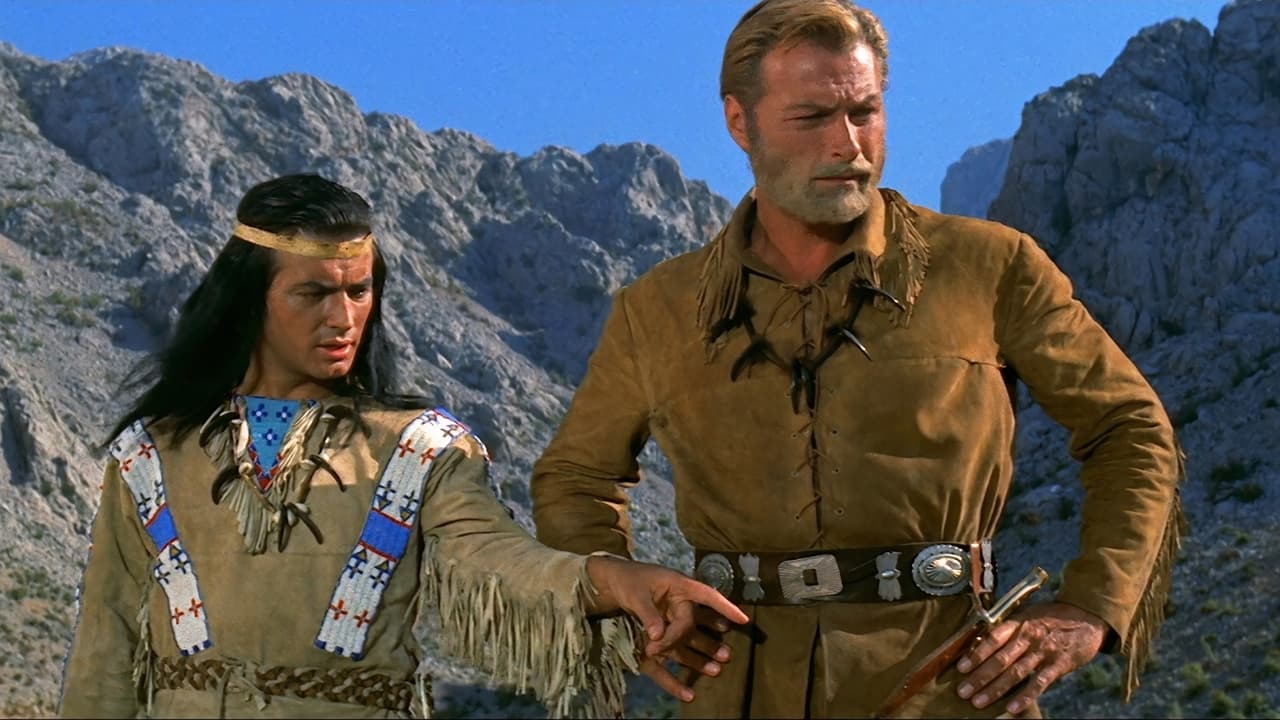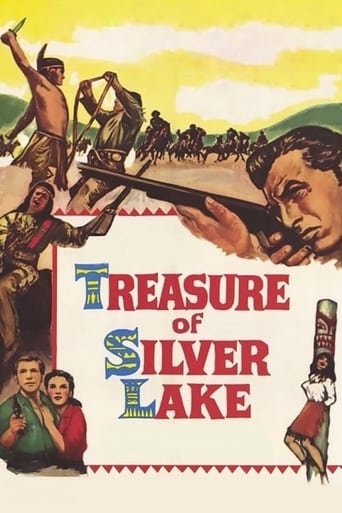



Sadly Over-hyped
If the ambition is to provide two hours of instantly forgettable, popcorn-munching escapism, it succeeds.
View MoreAlthough I seem to have had higher expectations than I thought, the movie is super entertaining.
View MoreThe plot isn't so bad, but the pace of storytelling is too slow which makes people bored. Certain moments are so obvious and unnecessary for the main plot. I would've fast-forwarded those moments if it was an online streaming. The ending looks like implying a sequel, not sure if this movie will get one
View More"Der Schatz im Silbersee" is a German western movie from almost 55 years ago and as it is a collaboration with other countries again, the cast here includes French actor Pierre Brice as Winnetou and several Yugoslavian actors in supporting roles. This 105-minute movie was the beginning to the really successful Winnetou franchise. I have seen some of these films and will probably see more in the future, but I personally am disappointed overall with the outcome. So with "successful", I am only referring to the commercial success. This one here also won a Golden Screen, so no surprise many other films would follow. The story here I found entirely disappointing and not memorable at all. It is probably not Brice's worst performance compared to some truly weak efforts later on, but the antagonists here are quite uninteresting and this lack of opposition hurt the film irreparably. Also, the title sounds a lot more interesting than the film finally turns out. For large parts of the film, the focus moves entirely away from the treasure and you wonder why it was even called like that. If you ask me, it was not really necessary to make more (or even many more) films after this one. But they loved the cash obviously. Final criticism: Götz George was criminally underused here. He would have been the one man who may have made this a more interesting watch, but he was not given the material. I do not recommend "The Treasure of the Silver Lake". Thumbs down.
View MoreLet me put this topic on a nationalistic setting - namely, that this movie, Treasure of Silver Lake or "Der Schatz im Silbersee" (1962) is strictly German movie and that it reflects a specific historical period of that country from 19th century, the literary Romanticism and struggle for Unification of the Masses. Karl May (1842-1912) as the protagonist writer of the adventure story came from a poor background and strive hard to make for a living his whole life. He was an enigmatic author for Germany, Adolf Hitler admitted he was overwhelmed by him as a boy and Albert Einstein was also great fan of his books. This is purely German phenomenon we have here of both exasperation and charm - viz, Karl May who used to tell his stories from first person had never visited America or the Orient or China before later years when he personally was devoted to Evangelism, whatsoever.We shouldn't regard May's literature as trivial or in that case that already during his lifetime he has been copied or parodied. He is one of the great writers of adventure literature from the period before the World Wars, together with Mayne Reid and Emilio Salgari. Their Indians are not ethnological North Americans but simply savages prone to evangelization. Their White Male characters are prototypes of the Superman from the 20th century, always justified and invincible. In the case of American Wild West stories their heroes lack historical accuracy although many of the plots develop in mid-nineteen centuries, presumably before the American Civil War 1862-1865 and with no certain American Geography. So don't look for typical Western Film and try use your imagination. I will further explicate myself.I have numerous historical books in my library on Modern American History but not a single volume about Indian Wars in literary perspective. I have some scattered materials on Zane Gray, Louis L'Amour, etc. but they are top-listing from 20th century and have numerous film adaptations. The fellows we are talking above are firstly coming from abroad (Germany, Ireland, Italy) and secondly, have historical sense that is indifferent to Anglo-American political issues. So they come and go as foreigners, more or less, the only common ground being Christianity of the advancing trappers or sometimes the eccentricity of a visiting European scholar. Women are always beautiful and stick to family values. I will speak by my memory since I have read those books long time ago and their plot is fuzzy in my mind, but Mayne Reid's books concern the period before American-Mexican War 1846-1848 where the titular was wounded in the thigh and returned to Ireland. After that he started to write books (from Ireland) about his past adventures and mostly dealing with Texas sharp-shooters; Mayne Reid doesn't speak about the defense of Alamo or General Santa Ana - which are subject to many American Films and stories. He did write about Tecumseh the Creek and Osceola the Seminole before they were defeated and sent to Indian Reservations. There were two films based on Reid's novels about those early Indian heroes that were produced by DEFA (formerly, the GDR Film Studio) with Serbian actor Gojko Mitic as principal star. The latter participated in the 1970s at some 20 Indian Films, all based on genuine book plots from Fenimore Cooper, Mayne Reid, Liselotte Welskopf-Henrich, etc.I will skip the material on Emilio Salgari, but he deserve special attention for his Far West Trilogy (1908) dealing with Chief Red Cloud the Sioux, his wife Yalla and daughter Minehaha, being persecuted by American trapper and agent John T. that was scalped by the Sioux. The book was exemplary 1000 pages, with some historical events and personages like Chivington Massacre and General Custer among others traversing 30 years of time. No railroads existing, which started to appear in the Wild West circa 1860s.Now let's go to Karl May. I will try to plot the geography of his novels and leave aside the timeline which is not very clear to me. By the time Old Shatterhand arrive in Santa Fe, the Great Plains are the last abode of Native Americans. Here still roam consolidated tribes of several ethnic groups (meaning, territory west of Mississippi River and no American States charted) - Kiowa, Cheyenne, Dakota, Sioux, Arapaho, Comanche and westernmost are Apache, Navajo; still further west are Shoshone and Ute). So looking back at a political map today, these are the states that join the American Union after the mentioned war with Mexico - firstly, Texas along the Rio Grande River; then New Mexico which is undivided and later its western part become Arizona. California become a state but at first is sparsely populated before the Gold Rush in 1870s. Between the Pacific Coast and the New Mexico territories to the North lies the state of Utah and then Nevada. Here principally develop the story in "Treasure of Silver Lake" with no big cattle towns and only wooden forts available. The concept of Cowboy or "cattle-herder" is non-existent yet.Finally, few words about the actors staff. Lex Barker and Pierre Brice (Winnetou) are excellent in their performance in all 13 movies of the Karl May franchise. Herbert Low (the Colonel Villain) is the most popular actor in this movie. He was Austro-Hungarian by birth and performed in 113 credits for Anglo-American productions. Lom died 95 years old in 2012. Thank You!
View MoreHaving read some of the comments on this film I feel somehow compelled to defend one of my favourite childhood movies. First off, I find it very odd that accuracy in the depiction of Indian culture and the what kind of equipment was used in a film made in the 1960s, when with very few exceptions (such as Cheyenne Autumn and Broken Arrow) American Westerns only depicted Indians as villains. Moreover, in the 1960s cinematography was maybe a bit more boring by modern music-video style cutting standards. Also, the prop work (costumes, the kind of guns and knives used etc....excuse me?) was simply making do with what you could get. This was not a multi-million-dollar budget movie, it was produced for German TV in a coproduction with Yugoslavia and I think Italy. Of course the story is full of clichés, and that's not surprising since Karl May never even left Germany, he was writing escapist romanticised fantasies of noble savages and cowboys fighting against evil savages and cowboys, it's not an ethnographic study on mid-19th-century Native American war-painting styles. It is still a very good and entertaining movie with likable characters, including some for comic relief. It is still the best of all the Karl May films, even though it greatly deviates from the book. When you see these films as an adult and don't know them from childhood I can understand they don't really grip you or blow you away. But they are classics. Their clichés, great music, and scenery make them so popular and the films have, along with the books, had a great impact on popular culture in Germany, even having spawned their own spoofs and parodies. If you are looking for factual accuracy, don't watch Westerns at all, if you just like a good adventure story, watch it.
View MoreThe first of the very popular Karl May films of the sixties in Germany is at the same time really embarrassing and touching with its simple good vs. evil plot. A German Western, shot at location in oops, Yugoslavia, is surely strange, but if Italian Western movies have their charme why not German?Winnetou and Old Shatterhand as played by Bierce and Barker have shaped our image of the way heroes have to look and behave. Götz George, arguably the best living German actor, plays one of his early roles and you can see that he is taking it not really seriously.I recently tried to watch it when it was on TV on prime time. There is a treasure somewhere in the "silver lake" and evil guys trying to steel the plan. Nothing really spectacular. But good supporting cast. It is really only endurable on a Sunday afternoon when you are relaxed and can enjoy the haunting film score. It helps to have read the books which are very popular in Germany. A perfect example of how the mood of a book can be recaptured with a movie. In fact one of my teachers said that the Karl May films were the only examples of films that come close to the literature that they are based on. And that only because the books are not worth much. It is not true really. There are other examples like...hm, Name of the Rose?
View More